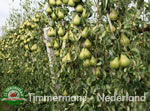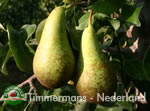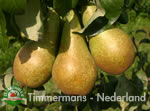 Up to the 1990s, Conference was considered a pear with good quality characteristics, but was particularly respected for its storage properties. Radical changes in the cultivation of Conference have clearly improved the average quality of the pears and consumers now consider this to be the most delicious eater. The trees are now pruned to be much more open, and they are further thinned by hand, reducing the amount of fruit per hectare to between 200,000 and 250,000 pears. Just as in viniculture, these measures have a considerable effect on the quality. In addition much more attention is paid to fertilization than in the past. Improved potassium uptake results in improved sugar levels, but also other nutrients such as nitrogen, magnesium, calcium, manganese, iron and zinc, influence the internal and external quality.
Up to the 1990s, Conference was considered a pear with good quality characteristics, but was particularly respected for its storage properties. Radical changes in the cultivation of Conference have clearly improved the average quality of the pears and consumers now consider this to be the most delicious eater. The trees are now pruned to be much more open, and they are further thinned by hand, reducing the amount of fruit per hectare to between 200,000 and 250,000 pears. Just as in viniculture, these measures have a considerable effect on the quality. In addition much more attention is paid to fertilization than in the past. Improved potassium uptake results in improved sugar levels, but also other nutrients such as nitrogen, magnesium, calcium, manganese, iron and zinc, influence the internal and external quality.
Thanks to these measures sugar levels in the fruit are much more even and, more importantly, much higher. These days most batches of pears have sugar levels between 12.5 and 14.5 °Brix, where in the past the majority of pears only reached about 10 or 11 °Brix. Generally speaking fruit with a sugar level above 12.5 °Brix is considered to have excellent flavour and above 11° Brix sufficient flavour. The flavour of fruit with a sugar level under 11 °Brix is unsatisfactory. Pears are usually harvested when the hardness of the fruit is in the range 5.5 to 6.5 kg/cm². After storage and a display period in the shop the hardness is usually 1 kg/cm² lower.
 The big advantage of Conference compared to other varieties of pear is that the fruit can be eaten at any stage of ripening. It can be eaten early in ripening when the fruit is crisp and the hardness is about 5 kg/cm² or at the end of ripening, when the hardness of the fruit is around 1.5 - 2 kg/cm². In this second case the pear is fully ripe, the flesh is butter soft, deliciously sweet and aromatic. Because of the rapid transition from hard to soft, it is important that pears are stored at a constant cold temperature (0 °C) throughout the distribution chain. Consumers are also well-advised to store pears in cool conditions.
The big advantage of Conference compared to other varieties of pear is that the fruit can be eaten at any stage of ripening. It can be eaten early in ripening when the fruit is crisp and the hardness is about 5 kg/cm² or at the end of ripening, when the hardness of the fruit is around 1.5 - 2 kg/cm². In this second case the pear is fully ripe, the flesh is butter soft, deliciously sweet and aromatic. Because of the rapid transition from hard to soft, it is important that pears are stored at a constant cold temperature (0 °C) throughout the distribution chain. Consumers are also well-advised to store pears in cool conditions.
There is considerable variation in the size of pears; the fruit varies from 45 mm to 80 mm in diameter. In well-managed cultivation only a small proportion of the fruit has a diameter less than 55 mm and about half is between 55 and 65 mm and the rest between 65 and 75 mm. Pears are graded per 5 mm.
The skin of a Conference usually has some degree of russeting. A slight degree of russeting is usually considered positive. However if the russet parts are too rough, course to touch, then this is considered to influence the quality of the fruit negatively.
 Throughout the distribution chain the background colour of the fruit should remain green. Generally, the lighter colour green the fruit, the riper it is, and light-yellow fruit is almost fully ripe and really only fit for immediate consumption. In some supermarket formulas Conference is marketed ripe and ready-to-eat, in which case the pears are usually predominantly light-yellow. If the pears turn dark yellow, then the fruit is overripe and no longer suitable for sale.
Throughout the distribution chain the background colour of the fruit should remain green. Generally, the lighter colour green the fruit, the riper it is, and light-yellow fruit is almost fully ripe and really only fit for immediate consumption. In some supermarket formulas Conference is marketed ripe and ready-to-eat, in which case the pears are usually predominantly light-yellow. If the pears turn dark yellow, then the fruit is overripe and no longer suitable for sale.
If when the fruit is cut the flesh is whitish-green and the surface remains reasonably dry, then the pear is not ripe enough to eat. However, if when the fruit is cut the flesh is hard, but the cut fruit is juicy, then the pear is ready to eat; the ideal ripeness for consumers who like hard pears. If the flesh is greenish-white and soft, then the pear has the ideal ripeness for consumers who like soft pears, full of flavour. As soon as the flesh becomes a yellowish green then the pear is overripe and loses flavour.
Source Fruitconsult - The Netherlands ( www.fruitconsult.com )Source Timmermans - The Netherlands ( www.timfruit.nl )